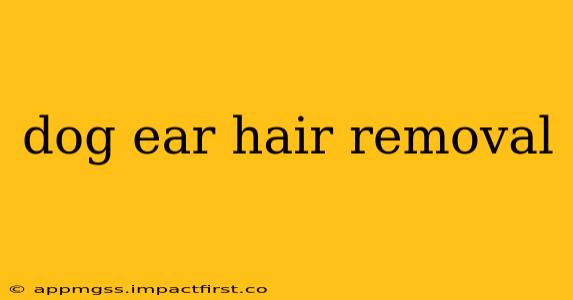Dealing with excessive hair in your dog's ears can be a common concern for pet owners. This guide will provide a comprehensive overview of dog ear hair removal, addressing various techniques, potential problems, and preventative measures. Ignoring excessive ear hair can lead to infections and discomfort for your furry friend, so understanding proper grooming is crucial.
Why is Hair Removal in Dog Ears Important?
Excessive hair in a dog's ears can trap moisture, debris, and bacteria, creating a breeding ground for infections. This can lead to ear infections, inflammation, and discomfort for your pet. Regular ear cleaning and hair removal are essential components of preventative care. The type of hair and breed heavily influence how much hair removal is necessary. Some breeds are naturally prone to more ear hair than others.
How to Remove Hair from Your Dog's Ears: Safe and Effective Methods
Several methods exist for removing hair from your dog's ears, ranging from simple home techniques to professional grooming services.
1. Plucking: A Gentle Approach
For dogs with manageable amounts of ear hair, plucking can be an effective and relatively painless method. Use specialized tweezers designed for pet grooming, or even blunt-ended scissors to carefully remove visible hairs. Important: Never pull forcefully; this can cause pain and injury. Work slowly and gently, rewarding your dog for cooperation.
2. Trimming: For Longer Hairs
If your dog has longer hairs in their ears, trimming with small, blunt-ended scissors is often preferred. Be extremely cautious to avoid the delicate skin inside the ear canal. Only trim the visible hair outside the ear canal.
3. Ear Powder: A Helpful Aid
Ear powder can help to absorb moisture and make hair easier to remove. Apply a small amount of dog-specific ear powder before plucking or trimming. Ensure the powder is specifically designed for pets, avoiding human-grade powders.
4. Professional Grooming: When to Seek Help
For dogs with excessive or deeply embedded ear hair, or those who are particularly sensitive, professional grooming is recommended. A groomer has the expertise and tools to safely and effectively remove hair without causing discomfort or injury.
What Tools Do I Need to Remove Dog Ear Hair?
The tools you need depend on the method you choose and your dog's hair type. Generally, you'll need:
- Blunt-ended scissors: Essential for trimming.
- Pet-specific tweezers: Ideal for plucking individual hairs.
- Dog-specific ear powder: Helps with easier removal.
- Treats: To reward your dog for good behavior.
- Soft cloth or cotton balls: For cleaning the ear after hair removal.
How Often Should I Remove Hair from My Dog's Ears?
The frequency of ear hair removal varies depending on your dog's breed, hair type, and individual needs. Some dogs may require it only every few months, while others may need it weekly or even more frequently. Regular inspection is key. If you notice a buildup of hair, it's time to groom.
What if My Dog Has an Ear Infection?
If you suspect your dog has an ear infection, do not attempt to remove hair yourself. An ear infection requires veterinary attention. Signs of an ear infection include redness, swelling, discharge, excessive scratching, and head shaking.
Are there any breeds more prone to ear hair problems?
Yes, certain breeds are genetically predisposed to more ear hair than others. Examples include Cocker Spaniels, Poodles, and Shih Tzus. These breeds often require more frequent ear cleaning and hair removal.
Can I use human ear hair removal methods on my dog?
No, human ear hair removal methods are generally not suitable for dogs. Their ear canals are more sensitive than humans, and some products can be irritating or harmful. Always use pet-specific products and techniques.
By following these guidelines and prioritizing regular ear care, you can help keep your dog's ears healthy, clean, and free from discomfort. Remember, consulting with your veterinarian is always a good idea if you have any concerns about your dog's ears.
